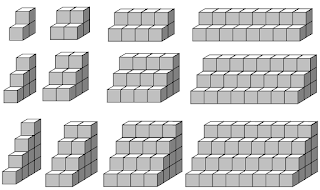Above shows rows 1, 2, 3 starting at the top. It also shows columns 1, 2, 3, 4 starting from the left to the right. At this rate, in row 8, column 10, there will be 23040 cubes. Can you find out how many cubes there will be for row 20, column 15?
Tuesday, January 15, 2013
Visual pattern of 3 variables
Since I have multi-input relationships on my mind, here is a visual pattern of 3 variables for you to enjoy (row, column, result). I've submitted this to the good folks at visualpatterns.org, but because of the nature of the complexity of this problem, I'm not quite sure that it quite fits well with everything else over there. Anyhow, it's a good problem for your abstract thinkers and ties in the concept of both arithmetic and geometric sequences quite nicely, I think.
Above shows rows 1, 2, 3 starting at the top. It also shows columns 1, 2, 3, 4 starting from the left to the right. At this rate, in row 8, column 10, there will be 23040 cubes. Can you find out how many cubes there will be for row 20, column 15?
Above shows rows 1, 2, 3 starting at the top. It also shows columns 1, 2, 3, 4 starting from the left to the right. At this rate, in row 8, column 10, there will be 23040 cubes. Can you find out how many cubes there will be for row 20, column 15?
Subscribe to:
Post Comments (Atom)

By the way the process for these (in case you are confused) is:
ReplyDeletefor row 1, observe that it is a geometric/exponential relationship starting with 3 blocks: y = 2^(column-1) * (1+2)
for row 2, observe that: y = 2^(column-1) * (1+2+3)
for row 3, observe that: y = 2^(column-1) * (1+2+3+4)
etc.
So clearly for any row:
y = 2^(column-1) * [sum from 1 to (row+1)]
y = 2^(column-1) * [1+(row+1)](row+1)/2
or, simplified, we get:
y = 2^(column-2) * (row+2) * (row+1)
It follows the general process for generalizing 3-variable relationships by focusing on the effect of one input at a time. Not commonly taught in the US but I think it's beneficial for students to see that functional relationships can certainly involve more than 1 input.
Hi Mimi! I'm giddily happy with your submission! It's a challenge for sure as it's our first 2-variable equation. I got 3,784,704 cubes in row 20, column 15.
ReplyDeleteRight, looking horizontally I see long bars of base 2 numbers. Looking vertically, I see triangular numbers. I think my students will recognize both of these numbers (we do A LOT of patterning!) but it'll be a nice challenge for them to work out the equation.
You're awesome, Mimi!!